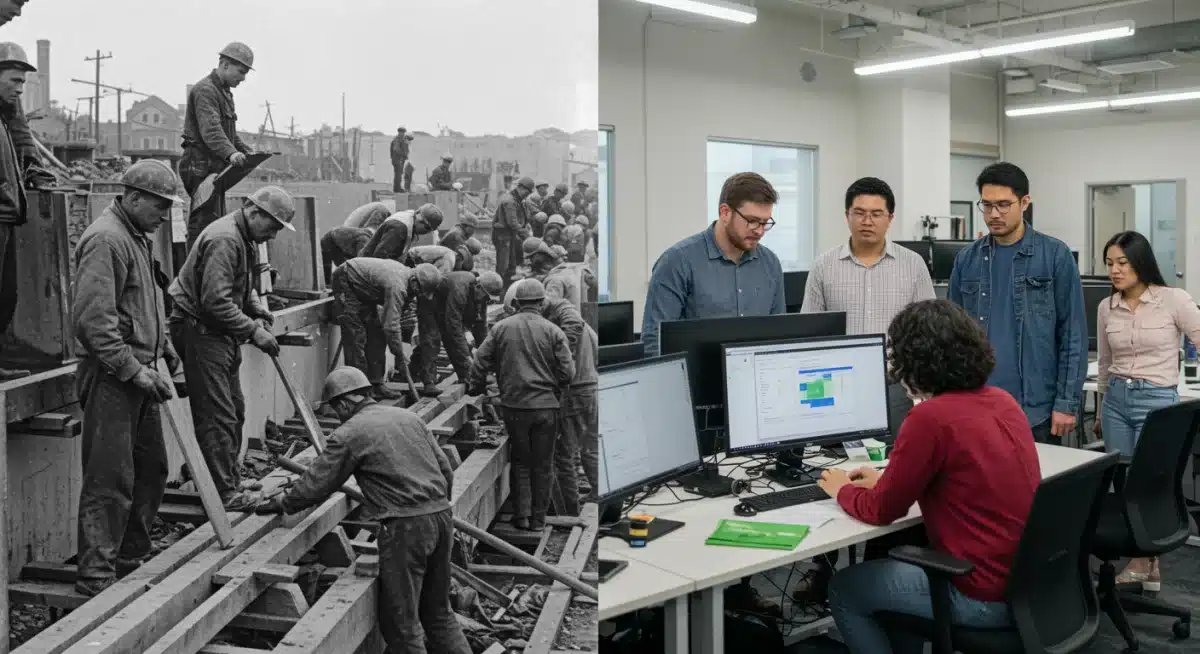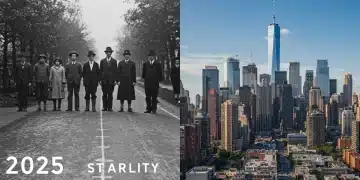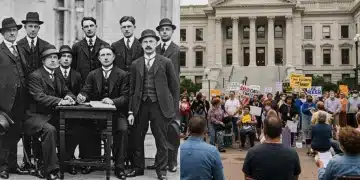The Economic Impact of the New Deal: Lessons for 2025 US Economy

The economic impact of the New Deal, a series of programs and reforms in the 1930s, continues to offer critical lessons for the United States economy in 2025 regarding government intervention, social safety nets, and infrastructure development.
As the United States economy navigates complex challenges in 2025, the historical precedent of The Economic Impact of the New Deal: Lessons from the 1930s for Today’s US Economy in 2025 becomes increasingly relevant. This landmark period of government intervention during the Great Depression offers invaluable insights into crisis management and economic recovery strategies.
Understanding the New Deal’s Core Economic Principles
The New Deal, enacted by President Franklin D. Roosevelt, represented a fundamental shift in American governance, moving from a largely laissez-faire approach to active government intervention in the economy. This comprehensive series of programs aimed at addressing the severe economic distress of the Great Depression through relief, recovery, and reform.
Central to its philosophy was the belief that the federal government had a responsibility to ensure the economic well-being of its citizens. This meant implementing policies that directly provided jobs, regulated financial markets, and established a social safety net, which were radical concepts at the time but have since become foundational aspects of the modern American state.
Relief Efforts and Immediate Impact
Immediate relief was a cornerstone of the New Deal, designed to alleviate widespread suffering. Programs like the Civilian Conservation Corps (CCC) and the Works Progress Administration (WPA) put millions of unemployed Americans to work on public projects, injecting much-needed wages into the economy and building vital infrastructure.
- Civilian Conservation Corps (CCC): Employed young men in national parks and forests, focusing on conservation.
- Works Progress Administration (WPA): Funded public works projects, from roads to schools, providing jobs across various skill levels.
- Federal Emergency Relief Administration (FERA): Provided direct cash assistance to states for distribution to the needy.
Recovery Strategies and Long-Term Goals
Beyond immediate relief, the New Deal also focused on long-term economic recovery. This involved efforts to stabilize agriculture, industry, and the financial system. The Agricultural Adjustment Act (AAA) sought to raise farm prices, while the National Industrial Recovery Act (NIRA) aimed to stimulate industrial production and reduce unemployment.
These recovery efforts were often controversial and faced legal challenges, but they laid the groundwork for a more regulated and stable economic environment. The goal was to restart the economic engines and prevent future depressions by addressing systemic issues that exacerbated the 1929 crash.
Key Programs and Their Enduring Legacy
Many New Deal programs had a profound and lasting impact, shaping the structure of the US economy and society for decades. These initiatives created institutions and policies that continue to function today, demonstrating their resilience and adaptability. Their lessons resonate when considering economic policy for 2025.
The establishment of social security, for instance, fundamentally altered the relationship between citizens and the state, providing a crucial safety net for the elderly and unemployed. This program alone has become an indispensable component of American social welfare, proving the long-term vision of New Deal architects.
Social Security Act: A Pillar of Modern Welfare
Enacted in 1935, the Social Security Act introduced a national system of social insurance. This included retirement benefits, unemployment compensation, and aid to dependent mothers and children, establishing a federal commitment to social welfare that was unprecedented.
- Retirement Benefits: Provided income to retirees, ensuring a basic standard of living.
- Unemployment Insurance: Offered temporary financial aid to those who lost their jobs.
- Aid to Dependent Children: Supported vulnerable families, addressing poverty among the youngest.
Financial Reforms and Regulatory Agencies
The New Deal also brought about significant reforms to the financial sector, designed to restore public confidence and prevent future crises. The creation of the Federal Deposit Insurance Corporation (FDIC) guaranteed bank deposits, while the Securities and Exchange Commission (SEC) regulated the stock market, curbing speculative excesses.
These agencies have become vital watchdogs, ensuring stability and transparency in financial markets. Their continued operation underscores the lasting importance of robust regulatory frameworks, a lesson particularly relevant for the US economy in 2025, given recent financial volatilities.
Economic Impact: Successes and Criticisms
Assessing the overall economic impact of the New Deal involves weighing its successes against its criticisms. While it undeniably provided relief and laid the groundwork for future stability, its role in ending the Great Depression is still debated among economists and historians.
Many credit the New Deal with preventing a complete collapse of the American economic and social fabric, stabilizing markets, and restoring public morale. However, critics argue that it prolonged the depression by increasing government debt, hindering private investment, and creating inefficiencies through extensive regulation.
Job Creation and Infrastructure Development
One of the most visible successes of the New Deal was its massive job creation efforts and the resulting infrastructure development. Projects ranging from national parks to rural electrification transformed the American landscape and improved living standards, especially in underserved areas.
- Public Works: Construction of roads, bridges, schools, and dams.
- Rural Electrification: Brought electricity to millions of rural homes and farms.
- Conservation Efforts: Reforestation, soil conservation, and flood control projects.
Debates on Economic Recovery Pace
The pace of economic recovery during the New Deal era remains a point of contention. Some argue that World War II, not the New Deal, ultimately pulled the US out of the depression due to massive wartime spending and industrial mobilization. Others contend that the New Deal created the necessary institutional framework for that mobilization to be effective.
Understanding this historical debate is crucial for policymakers in 2025, as they consider the efficacy of large-scale government interventions versus market-led recovery. The balance between direct aid, regulation, and stimulating private sector growth remains a complex policy challenge.
Lessons for the 2025 US Economy
The historical context of the New Deal offers critical lessons for understanding and addressing the economic challenges facing the United States in 2025. As the nation grapples with issues such as income inequality, infrastructure decay, and potential economic downturns, the New Deal’s legacy provides a blueprint for policy consideration.
One key takeaway is the importance of a robust social safety net in mitigating economic shocks. The enduring success of programs like Social Security demonstrates the long-term benefits of proactive government measures designed to protect vulnerable populations and stabilize consumption during crises.
Infrastructure Investment: A Timeless Strategy
The New Deal’s emphasis on public works and infrastructure development serves as a powerful reminder of the long-term economic benefits of such investments. In 2025, with aging infrastructure a pressing concern, lessons from the WPA and CCC can inform contemporary policy regarding job creation and national competitiveness.
- Modernizing Infrastructure: Investing in roads, bridges, and broadband internet.
- Green Initiatives: Funding projects related to renewable energy and environmental sustainability.
- Job Creation: Stimulating employment through large-scale public and private partnerships.

Regulatory Frameworks and Financial Stability
The financial reforms of the New Deal, particularly the establishment of the FDIC and SEC, highlight the necessity of strong regulatory frameworks to prevent financial crises. For 2025, as new financial technologies and global market complexities emerge, maintaining and adapting these regulatory safeguards is paramount.
The interconnectedness of today’s global economy means that financial instability in one sector or region can rapidly spread. The New Deal’s response to the banking crisis of the 1930s offers insights into restoring confidence and implementing effective oversight mechanisms.
Comparing New Deal Interventions to Modern Challenges
While the economic landscape of 2025 is vastly different from the 1930s, the underlying principles of government intervention during times of crisis remain relevant. Comparing the New Deal’s strategies to modern challenges reveals both similarities and divergences in approach and effectiveness.
Contemporary economic crises, such as the 2008 financial meltdown or the COVID-19 pandemic, have seen significant government responses, including stimulus packages and financial bailouts. These interventions often draw parallels to the New Deal’s broad scope and ambition, aiming to stabilize markets and support households.
Fiscal Stimulus vs. Direct Employment Programs
A key difference lies in the nature of government intervention. The New Deal heavily relied on direct employment programs, putting people to work on public projects. Modern responses, while sometimes including infrastructure spending, often favor fiscal stimulus through tax cuts, direct payments, or quantitative easing by central banks.
- New Deal Approach: Direct job creation through public works.
- Modern Approach: Broader fiscal stimulus, unemployment benefits, and monetary policy tools.
- Hybrid Models: Current discussions often explore combining direct investment with broader stimulus.
The Role of Technology and Globalization
The 2025 economy operates within a highly globalized and technologically advanced environment, factors largely absent during the 1930s. This complicates policy responses, as national solutions must consider international trade, global supply chains, and the rapid pace of technological change that can displace workers or create new industries.
Therefore, while the New Deal offers a historical framework, adapting its lessons requires careful consideration of these modern complexities. Policies must be agile enough to address issues like automation’s impact on employment, the rise of the gig economy, and the need for a skilled workforce in a digital age.
Potential Policy Adaptations for 2025
Drawing on the historical experience of the New Deal, policymakers in 2025 can consider several adaptations to address current and future economic challenges. The goal is not to replicate the past but to extract enduring principles and apply them to the unique circumstances of today’s economy.
One potential adaptation involves revitalizing public investment in critical sectors. This could include targeted infrastructure projects, investments in green energy technologies, and robust funding for research and development, all designed to stimulate economic growth and create future-proof jobs.
Targeted Job Creation and Workforce Development
Instead of broad public works, 2025 might see more targeted job creation initiatives focused on emerging industries or areas with high unemployment. This could be coupled with significant investments in workforce training and reskilling programs to ensure workers have the skills needed for the jobs of tomorrow.
- Green Jobs Initiatives: Training and employment in renewable energy and sustainable technologies.
- Digital Infrastructure: Building out broadband access and digital literacy programs.
- Healthcare Workforce: Investing in training for healthcare professionals to meet growing demand.
Strengthening Social Safety Nets for the Future
The New Deal’s legacy of social safety nets can be adapted to address 21st-century vulnerabilities. This might involve re-evaluating unemployment benefits for gig workers, expanding access to affordable healthcare, or exploring universal basic income pilots to provide a foundational economic security in an increasingly automated world.
Such adaptations would aim to reinforce the protective measures that prevent individual economic hardship from escalating into broader societal crises, a core lesson from the New Deal’s response to the widespread suffering of the Great Depression.
| Key Point | Brief Description |
|---|---|
| Government Intervention | New Deal established active federal role in economy; 2025 evaluates its necessity in crises. |
| Social Safety Nets | Social Security’s enduring legacy informs 2025 debates on universal basic income and welfare. |
| Infrastructure Investment | New Deal’s public works inspire 2025 calls for modernizing infrastructure and green projects. |
| Financial Regulation | FDIC and SEC models guide 2025 efforts to maintain financial stability amid new tech. |
Frequently Asked Questions About the New Deal’s Economic Impact
▼
The primary economic goal of the New Deal was to provide relief to those suffering from the Great Depression, foster economic recovery, and implement reforms to prevent future economic crises. It aimed to stabilize markets and restore public confidence through active government intervention.
▼
Historians and economists debate this. While the New Deal mitigated suffering and stabilized the economy, many argue that full recovery and an end to the Great Depression were ultimately achieved with the massive industrial mobilization for World War II.
▼
The Social Security Act of 1935 was a cornerstone of the New Deal. It established a national system of social insurance, providing retirement benefits, unemployment compensation, and aid to vulnerable families, creating a lasting social safety net.
▼
Lessons for 2025 include the importance of robust social safety nets, strategic infrastructure investment, and effective financial regulation during economic downturns. These principles guide current discussions on economic resilience and crisis response.
▼
Not all New Deal programs achieved their intended goals, and many faced significant criticism and legal challenges. However, the overall impact was transformative, establishing a new role for government in managing the economy and protecting citizens.
Looking Ahead: New Deal Principles in a Modern Context
The ongoing dialogue surrounding The Economic Impact of the New Deal: Lessons from the 1930s for Today’s US Economy in 2025 underscores a fundamental truth: historical precedents offer invaluable guidance for future policy. As the US economy continues to evolve, facing new technological shifts, global competition, and potential crises, the adaptive spirit and core principles of the New Deal remain relevant. Policymakers in 2025 are likely to continue grappling with how to balance government intervention with market forces, ensure economic security for all citizens, and invest in a resilient future, all while navigating a vastly different world than that of the 1930s. The debate is not about exact replication, but about extracting wisdom from the past to inform dynamic solutions for tomorrow’s challenges.





